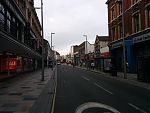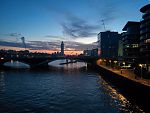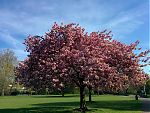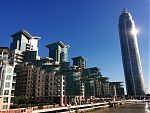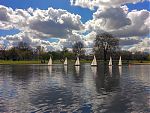28. Dezember 2019
London ─ As far as the eye can see
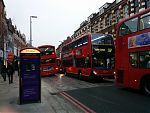 London is large enough to accommodate the population of Switzerland • speed flatmating is not for me • receiving solace from Thomas Edison • London is more than what you can see on the tube map • Nappy Valley • between the Commons • some fences are pointless • houses, as far as the eye can see.
London is large enough to accommodate the population of Switzerland • speed flatmating is not for me • receiving solace from Thomas Edison • London is more than what you can see on the tube map • Nappy Valley • between the Commons • some fences are pointless • houses, as far as the eye can see.
This is the second article in my series on London ─ Living through History.
The sheer size! London is huge. It is obviously no longer as small as Londinium was during the times of the Romans. Approximately 1500 years later: houses, as far as the eye can see, enough to accommodate the population of Switzerland. And one of the houses to become my new home. I got my first impression of the expanse when I took a taxi from Heathrow to Pimlico after arrival in April 2014. Back then I did not know yet, how much and yet so little I was to discover of London within the years to follow.
Where to live?
Moving to a new place is followed by a lot of banal activities, among them homesearch. How to accomplish that if you never searched for accommodation before (other than student accommodation)? Where to live? London is huge. Houses as far as the eye can see. But I see London less of a city, but rather an amalgamation of smaller cities; which once upon a time were parishes in the countryside such as Clapham, or Stoke Newington. Each part of London is shaped by history. For example, the character of Brixton is influenced by its Afro-Caribbean community, which we can trace back to immigration in the 1950s:
The Empire Windrush sailed into Tilbury on 22 June 1948 with 492 jobseekers, mostly young men. Colonial Office officials met them and accommodated some in an old air raid shelter, whose nearest labour exchange was at Brixton, where many settled ─ the seed of a new community.1
In my case, my commute requirements would narrow down the choices. For the first few weeks, I was in temporary accommodation in Pimlico. This was a good base because it was close to my workplace in London. Every time I ventured anywhere in London from my temporary accommodation, I would learn a bit more about possible commute times. Commuting is an important topic to Londoners. And I knew that commuting was important topic for me, too. Previously all my commutes were either by bike, by foot, a few stops with the underground, and usually less than 30 minutes. And I intended to keep it like that.
1 Tombs, Robert. 2016. The English and their history.
Speed flatmating is not for me
As I mentioned, I had no prior experience in homesearch other than student accommodation. So I experimented with finding a flatshare through match-making “speed flatmating” events, where existing tenants can find new flatmates. I found it awful. Superficial. Or maybe I just suck at this game. In any case, it’s time to quota Thomas Edison at this point:
I said: ‘Isn’t it a shame that with the tremendous amount of work you have done you haven’t been able to get any results?’ Edison turned on me like a flash, and with a smile replied: ‘Results! Why, man, I have gotten a lot of results! I know several thousand things that won’t work.’2
2 Dyer, Frank L., and Martin, Thomas c. 2010. Edison, his life and inventions.
Settling in Wandsworth
Fortunately, I had some homesearch assistance that I could draw upon. And this way, I got shown around the southwest of London. The southwest of London is hardly on the tube map, and is thus easy to miss. However, the guy who showed me around told me where he lived: close to Clapham Junctio. I realized that this is essentially 1-2 stops with the train away from Victoria. So I took my newly gained knowledge, and put myself into a new flatshare rented out by an agency who in turn rented a place from a landlord and divvied up the space. London’s expensive, but am I telling you something that you didn’t already know?
The flatshare was close to near Clapham Junction, in the borough of Wandsworth, located in a terraced house in a side street of Northcote Road─a road nicknamed “Nappy Valley” for its popularity with young families. It has some some quaint shops, plus the usual bunch of chain stores (which make every place look the same). The real estate agents call the area “between the commons” because of its proximity to both Wandsworth Common in the west and Clapham Common to the east.
Know [not] your neighbors
The flatshare had a little patio in the back, surrounded by ridiculously high fences. I always wondered about disproportionally high fences around disproportionally small gardens in London. No surprise that I hardly knew my neighbours. Later, I learnt, not knowing your neighbours is not an uncommon thing in London.
The pinnacle of our interaction with the neighbour family was when the dad brought over a bottle of champagne as an apology for the kids throwing balls over the fence into our “garden” more often than usual. What the dad didn’t know was that my flatmate had taught them to say “Hoppla” everytime the ball went over the fence. The kids found it so funny they threw the ball over the fence on purpose. We took the champagne anyway and lost a bottle of wine in return later (due to another ball going over the fence). In any case, the anonymity was a bit different than I was used to.
As far as the eye can see
In Wandsworth, I was surrounded by houses and more houses. As far as the eye can see. By roads and more roads. By cars and more cars. Despite of Wandsworth Common and Clapham Common within walking distance, I found myself a bit overwhelmed in the first months by the never-ending sea of urban area ariund me. Don’t get me wrong, London is surprisingly green for its size. But, I had previously lived in a student accommodation surrounded by park, by water, by forest.
Thus, it was a huge change, but I found myself rapidly adapting. What helped was that Clapham Junction is a very busy railway station, with trains in abundance linking the south and southwest of London with Victoria Station and Waterloo Station. The location turned out not only to be convenient when travelling to work; but also a great base for venturing out into the countryside.
